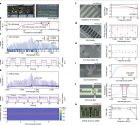You are using an out of date browser. It may not display this or other websites correctly.
You should upgrade or use an alternative browser.
You should upgrade or use an alternative browser.
Chinese semiconductor industry
- Thread starter Hendrik_2000
- Start date
- Status
- Not open for further replies.
damn, UNISOC overtook MediaTek. That's pretty big. and ASR is Chinese too.
This is IoT, not smartphone chipset.
UNISOC relies on TSMC for foundry....better for UNISOC don't grow too much or they will receive the Phytium treatment.
Regarding Phytium, someone has recent info on the company? Did they close 2021 with a loss? What is current revenue?
Searching on the net, I got the impression that Phytium suffered a heavy blow from the banning out of TSMC, but maybe I missed some new info.
...until China will not localize EUV, it will be like walking on the eggs for these advanced processor's manufacturers.
Phytium 2021 revenue reached 2.2 billions. 30% profit.This is IoT, not smartphone chipset.
UNISOC relies on TSMC for foundry....better for UNISOC don't grow too much or they will receive the Phytium treatment.
Regarding Phytium, someone has recent info on the company? Did they close 2021 with a loss? What is current revenue?
Searching on the net, I got the impression that Phytium suffered a heavy blow from the banning out of TSMC, but maybe I missed some new info.
...until China will not localize EUV, it will be like walking on the eggs for these advanced processor's manufacturers.
飞腾是PKS 生态核心之一,长城在其中持股28.035%。目前飞腾在信创领域市占率第一,2021 飞腾营收接近翻倍,达22.18 亿元,且净利率达到29.44%,比2020 提升2.62pcts。
Smartphone SOC share in 2022 is 11% from 1% in 2019This is IoT, not smartphone chipset.
UNISOC relies on TSMC for foundry....better for UNISOC don't grow too much or they will receive the Phytium treatment.
Regarding Phytium, someone has recent info on the company? Did they close 2021 with a loss? What is current revenue?
Searching on the net, I got the impression that Phytium suffered a heavy blow from the banning out of TSMC, but maybe I missed some new info.
...until China will not localize EUV, it will be like walking on the eggs for these advanced processor's manufacturers.
Microcomb-driven silicon photonic systems
Microcombs have sparked a surge of applications over the past decade, ranging from optical communications to metrology,,,. Despite their diverse deployment, most microcomb-based systems rely on a large amount of bulky elements and equipment to fulfil their desired functions, which is complicated, expensive and power consuming. By contrast, foundry-based silicon photonics (SiPh) has had remarkable success in providing versatile functionality in a scalable and low-cost manner,,, but its available chip-based light sources lack the capacity for parallelization, which limits the scope of SiPh applications. Here we combine these two technologies by using a power-efficient and operationally simple aluminium-gallium-arsenide-on-insulator microcomb source to drive complementary metal–oxide–semiconductor SiPh engines. We present two important chip-scale photonic systems for optical data transmission and microwave photonics, respectively. A microcomb-based integrated photonic data link is demonstrated, based on a pulse-amplitude four-level modulation scheme with a two-terabit-per-second aggregate rate, and a highly reconfigurable microwave photonic filter with a high level of integration is constructed using a time-stretch approach. Such synergy of a microcomb and SiPh integrated components is an essential step towards the next generation of fully integrated photonic systems.Fig. 1: Microcomb-based SiPh optoelectronic systems.
Conceptual drawings for several integrated optoelectronic systems (data transmission, microwave photonic signal processing, optical beam steering and photonic computing) realized by combining a microcomb source with silicon photonic chips. With III–V-on-silicon photonic integration, the chips are expected to contain all the essential functions (for example, laser-microcomb generation, passive and active optical components, and the electronics for supporting signal processing and system control).

It is IoT, not phones. IoT is "Internet of Things" like remote electricity meters, sensors, home appliances and vichecles etc.Which phones use UNISOC? Have seen any of their chipsets in consumer electronics that I have used before.
That is absurd suggestion. Why should one give an easy victory to the enemy instead of inflicting casualty on the enemy?This is IoT, not smartphone chipset.
UNISOC relies on TSMC for foundry....better for UNISOC don't grow too much or they will receive the Phytium treatment.
Besides, China's 5/7 nm production line is ready this year. TSMC isn't the only option any more.
Intel Engineers Want to Unionize
More than 350 Intel employees are leading “the biggest unionization effort Intel has ever faced.”During a company press conference last week, engineer and Oregon Congressional candidate Matt West called on the tech giant to agree not to interfere with his colleagues’ growing organizing force. The group, which has been meeting in private for more than a year, asked Intel to voluntarily acknowledge their unofficial union and sign a neutrality agreement (AKA a promise not to union-bust). Whether Intel signed the agreement is currently unknown.

Well folks there goes America semiconductors dreams.
Better start poaching Taiwanese engineers like crazy.
"Semiconductor Manufacturing International Corp. (SMIC) saw sales grow by more than 66% during the first three months of this year as the company warned of weakening demand in China, its home market.
...
“Smartphones, consumer products, PCs, and internet…they’ve dropped like a rock,” SMIC co–CEO Haijun Zhao told analysts on a conference call last week. “Some customers hold five months of inventory in the supply chain. Oversupply is very serious.”
The company has switched production to address shortages of power management ICs and AMOLED drivers as well as MCUs and parts for WiFi 6, where demand remains strong.
...
SMIC’s reliance on the Chinese market during the first quarter this year swelled to 68% of its total demand compared to 56% in the same period a year ago. The company’s sales to North America, its second–largest market, dropped to 19% of overall demand from 28% during the same period."

- Status
- Not open for further replies.
